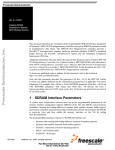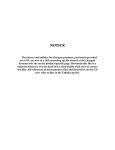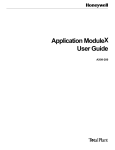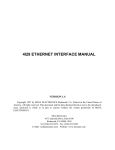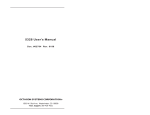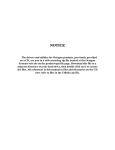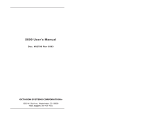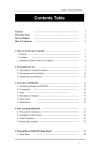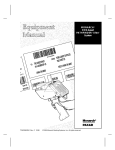Download 5554 Quad Serial - Octagon Systems
Transcript
NOTICE
The drivers and utilities for Octagon products, previously provided
on a CD, are now in a self-extracting zip file located at the Octagon
Systems web site on the product-specific page. Download this file to a
separate directory on your hard drive, then double click on it to extract
the files. All references in this manual to files and directories on the CD
now refer to files in the Utilities zip file.
5554/5558
User’s Manual
Doc. #03580 Rev 0198
OCTAGON SYSTEMS CORPORATION®
6510 W. 91st Ave. Westminster, CO 80030
Tech. Support: 303–426–4521
COPYRIGHT
Copyright 1993–94, 1998—Octagon Systems Corporation. All
rights reserved. However, any part of this document may be
reproduced, provided that Octagon Systems Corporation is cited as
the source. The contents of this manual and the specifications
herein may change without notice.
TRADEMARKS
Micro PC, PC SmartLink, Octagon Systems Corporation®, the
Octagon logo and the Micro PC logo are trademarks of Octagon
Systems Corporation. QuickBASIC® is a registered trademark of
Microsoft Corporation. ROM-DOS is a trademark of Datalight.
NOTICE TO USER
The information contained in this manual is believed to be correct.
However, Octagon assumes no responsibility for any of the circuits
described herein, conveys no license under any patent or other
right, and makes no representations that the circuits are free from
patent infringement. Octagon makes no representation or warranty that such applications will be suitable for the use specified
without further testing or modification.
Octagon Systems Corporation general policy does not recommend
the use of its products in life support applications where the
failure or malfunction of a component may directly threaten life or
injury. It is a Condition of Sale that the user of Octagon products
in life support applications assumes all the risk of such use and
indemnifies Octagon against all damage.
IMPORTANT!
Please read before installing your product.
Octagon's products are designed to be high in performance while
consuming very little power. In order to maintain this advantage,
CMOS circuitry is used.
CMOS chips have specific needs and some special requirements
that the user must be aware of. Read the following to help avoid
damage to your card from the use of CMOS chips.
Using CMOS Circuitry – 1
Using CMOS Circuitry in Industrial Control
Industrial computers originally used LSTTL circuits. Because
many PC components are used in laptop computers, IC manufacturers are exclusively using CMOS technology. Both TTL and
CMOS have failure mechanisms, but they are different. This
section describes some of the common failures which are common
to all manufacturers of CMOS equipment. However, much of the
information has been put in the context of the Micro PC.
Octagon has developed a reliable database of customer-induced,
field failures. The average MTBF of Micro PC cards exceeds
11 years, yet there are failures. Most failures have been identified
as customer-induced, but there is a small percentage that cannot
be identified. As expected, virtually all the failures occur when
bringing up the first system. On subsequent systems, the failure
rate drops dramatically.
■
Approximately 20% of the returned cards are problem-free.
These cards, typically, have the wrong jumper settings or the
customer has problems with the software. This causes
frustration for the customer and incurs a testing charge from
Octagon.
■
Of the remaining 80% of the cards, 90% of these cards fail due
to customer misuse and accident. Customers often cannot
pinpoint the cause of the misuse.
■
Therefore, 72% of the returned cards are damaged through
some type of misuse. Of the remaining 8%, Octagon is unable
to determine the cause of the failure and repairs these cards at
no charge if they are under warranty.
The most common failures on CPU cards are over voltage of the
power supply, static discharge, and damage to the serial and
parallel ports. On expansion cards, the most common failures are
static discharge, over voltage of inputs, over current of outputs,
and misuse of the CMOS circuitry with regards to power supply
sequencing. In the case of the video cards, the most common
failure is to miswire the card to the flat panel display. Miswiring
can damage both the card and an expensive display.
■
Multiple component failures - The chance of a random
component failure is very rare since the average MTBF of an
Octagon card is greater than 11 years. In a 7 year study,
Using CMOS Circuitry – 2
Octagon has never found a single case where multiple IC
failures were not caused by misuse or accident. It is very
probable that multiple component failures indicate that they
were user-induced.
■
Testing “dead” cards - For a card that is “completely
nonfunctional”, there is a simple test to determine accidental
over voltage, reverse voltage or other “forced” current
situations. Unplug the card from the bus and remove all
cables. Using an ordinary digital ohmmeter on the 2,000 ohm
scale, measure the resistance between power and ground.
Record this number. Reverse the ohmmeter leads and
measure the resistance again. If the ratio of the resistances is
2:1 or greater, fault conditions most likely have occurred. A
common cause is miswiring the power supply.
■
Improper power causes catastrophic failure - If a card
has had reverse polarity or high voltage applied, replacing a
failed component is not an adequate fix. Other components
probably have been partially damaged or a failure mechanism
has been induced. Therefore, a failure will probably occur in
the future. For such cards, Octagon highly recommends that
these cards be replaced.
■
Other over-voltage symptoms - In over-voltage situations,
the programmable logic devices, EPROMs and CPU chips,
usually fail in this order. The failed device may be hot to the
touch. It is usually the case that only one IC will be
overheated at a time.
■
Power sequencing - The major failure of I/O chips is caused
by the external application of input voltage while the Micro PC
power is off. If you apply 5V to the input of a TTL chip with
the power off, nothing will happen. Applying a 5V input to a
CMOS card will cause the current to flow through the input
and out the 5V power pin. This current attempts to power up
the card. Most inputs are rated at 25 mA maximum. When
this is exceeded, the chip may be damaged.
■
Failure on power-up - Even when there is not enough
current to destroy an input described above, the chip may be
destroyed when the power to the card is applied. This is due
to the fact that the input current biases the IC so that it acts
as a forward biased diode on power-up. This type of failure is
typical on serial interface chips.
Using CMOS Circuitry – 3
■
Serial and parallel - Customers sometimes connect the serial
and printer devices to the Micro PC while the power is off.
This can cause the failure mentioned in the above section,
Failure upon power-up. Even if they are connected with the
Micro PC on, there can be another failure mechanism. Some
serial and printer devices do not share the same power (AC)
grounding. The leakage can cause the serial or parallel signals
to be 20-40V above the Micro PC ground, thus, damaging the
ports as they are plugged in. This would not be a problem if
the ground pin is connected first, but there is no guarantee of
this. Damage to the printer port chip will cause the serial
ports to fail as they share the same chip.
■
Hot insertion - Plugging cards into the card cage with the
power on will usually not cause a problem. (Octagon urges
that you do not do this!) However, the card may be damaged if the right sequence of pins contacts as the card is
pushed into the socket. This usually damages bus driver chips
and they may become hot when the power is applied. This is
one of the most common failures of expansion cards.
■
Using desktop PC power supplies - Occasionally, a customer will use a regular desktop PC power supply when
bringing up a system. Most of these are rated at 5V at 20A or
more. Switching supplies usually require a 20% load to
operate properly. This means 4A or more. Since a typical
Micro PC system takes less than 2A, the supply does not
regulate properly. Customers have reported that the output
can drift up to 7V and/or with 7-8V voltage spikes. Unless a
scope is connected, you may not see these transients.
■
Terminated backplanes - Some customers try to use Micro
PC cards in backplanes that have resistor/capacitor termination networks. CMOS cards cannot be used with termination
networks. Generally, the cards will function erratically or the
bus drivers may fail due to excessive output currents.
■
Excessive signal lead lengths - Another source of failure
that was identified years ago at Octagon was excessive lead
lengths on digital inputs. Long leads act as an antenna to pick
up noise. They can also act as unterminated transmission
lines. When 5V is switch onto a line, it creates a transient
waveform. Octagon has seen submicrosecond pulses of 8V or
more. The solution is to place a capacitor, for example 0.1 µF,
across the switch contact. This will also eliminate radio
frequency and other high frequency pickup.
Using CMOS Circuitry – 4
TABLE OF CONTENTS
PREFACE ......................................................................... 1
Conventions Used In This Manual .................................................... 1
Symbols and Terminology .................................................................. 2
Technical Support ............................................................................... 3
CHAPTER 1: OVERVIEW ............................................... 5
Major Features .................................................................................... 5
CHAPTER 2: INSTALLATION ........................................ 7
Equipment ........................................................................................... 7
Installation .......................................................................................... 7
Base Address .............................................................................. 10
Interrupt Selection ..................................................................... 10
Installing the 5554/5558 ............................................................ 13
CHAPTER 3: RS–422/485 ............................................ 15
RS–422/485 Compatibility ................................................................
Operating Precautions ......................................................................
Baud Rate ...................................................................................
Two or Four Wire Communication ...........................................
Transmission Timing .................................................................
Programming Example ..............................................................
15
16
16
16
17
18
CHAPTER 4: TECHNICAL DATA ................................. 21
Technical Specifications ...................................................................
Jumper Settings ................................................................................
Connector Pinouts .............................................................................
PC Bus Pinouts ..................................................................................
WARRANTY
i
21
22
24
25
ii
PREFACE
This manual is a guide to the proper configuration, installation,
and operation of your 5554/5558 Quad/Octal Serial Card. The
5554/5558 expansion card is part of the Octagon Micro PC system.
It is designed to be used with any other Micro PC Control Cards.
You can use your 5554/5558 card in conjunction with other Micro
PC expansion cards, tailoring your system for a wide variety of
applications. The 5554/5558 card can also be used in an IBMcompatible PC. Micro PC cards are too tall to fit in an XT, but will
fit in AT industrial size and other AT-size cases. All Micro PC
products are modular, so creating a system is as easy as selecting
and plugging in the products you need.
CONVENTIONS USED IN THIS MANUAL
1.
Information which appears on your screen (output from your
system or commands or data that you key in) is shown in a
different type face (note: the line breaks may not match those
on your screen, but the message will be similar).
Example 1:
Octagon 5025 ROM BIOS Vers X.XX
Copyright (c) 1992, 1993 Octagon Systems, Corp.
All Rights Reserved
Example 2:
Press the <ESC> key.
2.
Italicized refers to information that is specific to your particular system or program. For example:
Enter filename
means enter the name of your file. Names of other sections or
manuals are also italicized.
3.
Warnings always appear in this format:
WARNING: The warning message appears here.
Preface – 1
4.
Paired angle brackets are used to indicate a specific key on
your keyboard. For example, <ESC> means the escape key;
<CTRL> means the control key; <F1> means the F1 function
key.
5.
All addresses are given in hexadecimal.
SYMBOLS AND TERMINOLOGY
Throughout this manual, the following symbols and terminology
are used:
W[ - ]
Denotes a jumper block and the pins to
connect.
NOTE
Information under this heading presents
helpful tips for using the 5700 Card.
WARNING:
Information under this heading warns
you of situations which might cause
catastrophic or irreversible damage.
H
The suffix “H” denotes a hexadecimal
number. For example, 1000H in hexadecimal equals 4096 in decimal.
TTL Compatible
Transistor-transistor-logic compatible;
0-5V logic levels.
Preface – 2
TECHNICAL SUPPORT
If you have a question about the 5554/5558 expansion card and
cannot find the answer in this manual, call Technical Support.
They will be ready to give you the assistance you need.
When you call, please have the following at hand:
Your 5554/5558 Quad/Octal Serial Card User’s Manual
A description of your problem
The direct line to Technical Support is 303-426-4521.
Preface – 3
This page intentionally left blank.
Preface – 4
CHAPTER 1
OVERVIEW
The 5554/5558 Quad/Octal Serial Card is designed for applications
which require intensive serial communications such as protocol
translation, multiple bar code readers and radio modems. 16–byte
transmit–and–receiver FIFOs minimize overhead by the Control
Card. The card is 4.5 in. x 4.9 in. and operates over a wide
temperature range from –40° to 85° C and requires only 5V for
operation.
MAJOR FEATURES
4/8 Serial Ports
The 5554/5558 comes with either four or eight RS–232 serial ports.
Two of the ports are jumper selectable to RS–422/485 operation.
RS–485 Operation
Both RS–485 ports use a 5–position terminal block. The blocks are
routed to serial ports three and four. Each of the two RS–485
ports can be terminated or unterminated via jumper block W5.
Industry Standard 16C450 UART Compatible
Each of the serial channels can operate either in a polled or
interrupt mode. The interrupt mode is enabled via an internal
register of the 16C554 controller and associated jumpers. Each of
the interrupts is funneled into a single interrupt that can be
jumpered to one of the hardware interrupts, IRQ3 to IRQ7. The
interrupt request status of all channels can be read from a single
“read only” location to resolve which of the channels on the board
require service.
Overview – 5
This page intentionally left blank.
Overview – 6
Chapter 2
INSTALLATION
The 5554/5558 Quad/Octal Serial Card uses one slot of the Micro
PC card cage. It may be used with any Micro PC Control Card or
Microcontroller.
WARNING:
The 5554/5558 contains static sensitive CMOS
components. The greatest danger occurs when
the card is plugged into a card cage. The card
becomes charged by the user and the static
discharges to the backplane from the pin closest
to the card connector. If that pin happens to be
an input pin, even TTL inputs may be damaged.
To avoid damaging your card and its components:
1.
Ground yourself before handling the 5554/
5558 Quad/Octal Serial Card.
2.
Disconnect power before removing or
inserting the 5554/5558 card.
EQUIPMENT
You will need the following equipment (or equivalent) to use your
5554/5558.
•
•
•
•
•
•
Micro PC Control Card or Microcontroller
5554/5558 Quad/Octal Serial Card
5554/5558 Utility Disk
Micro PC Card Cage
Power Module
PC SmartLINK or other communications software
INSTALLATION
Before installing the 5554/5558 Quad/Octal Serial Card, refer to
Figure 2–1 for the location of various connectors and jumpers and
to Figure 2–2 for functional block information:
Installation – 7
Interrupt Select
RS-422/485 Select
and Network
Termination
U7
U11
J2
J1
W1 W2
1 2
RS-232
U10
U12
W3
1
5
U4
U1
11
W4
Base Address
Select and
Quad/Octal
Select
W5
1
1
17
2
U14
J3
P3
G R- R+ T- T+
Interrupt
Channeling
J4
P2
J6
G R- R+ T- T+
1 2
U2
J5
RS-232
U13
U3
RS-422/485
U5
U15
J8
J7
Figure 2–1—5554/5558 Component Diagram
Installation – 8
J1
Transceivers
Port 2
RS-422/485
Config &
Termination
Port 3
Base + 7
P2
P3
RS-422/
485
J4
Port 4
RS-422/
485
Interrupt Register
W5
J3
Port 3
Ports 1-4
Address Buffers
& Decode Logic
J2
Port 1
Quad
Serial I/O
Control
J5
Port 4
Ports 5-8
Port 6
J6
Port 5
Port 7
Port 8
J7
Quad
Serial I/O
Control
J8
Interrupt Funnel
W3
W1
W4
W2
PC Bus
Data Buffers
Access
Indicator
Figure 2–2—5554/5558 Functional Block Diagram
Installation – 9
Base Address
The 5554/5558 is configured at the factory to operate in most
systems without any jumper changes. Jumper block W4 defines
the base address of serial port 1. As shipped, the base address of
serial port 1 is 100H, which is jumper configuration W4[1–2][3–4].
If there is another card in your system with a base address of
100H, you must use a different base address for the 5554/5558 or
the other expansion card.
W4: Base Address Select
Pins Jumpered
Base Address
5554 Quad
5558 Octal
[1-2] [3-4][5-6]
[1-2][3-4]
100H*
[1-2][5-6]
[1-2]
140H
[3-4][5-6]
[3-4]
180H
[5-6}
Not jumpered
1C0H
* = default
NOTE: Jumpers [5-6] should not be connected on the
5558 Octal Card
Interrupt Selection
There are five interrupts available on the 5554/5558. The following table lists the available interrupts and appropriate jumper
settings:
Installation – 10
W1 & W2: Interrupt Select
Pins Jumpered
IRQ
Reserved for
DOS
W1
W2
[1-2]
[1-2]
IRQ 3
COM2 & COM4
[3-4]
[3-4]
IRQ 4
COM1 & COM3
[5-6]
[5-6]
IRQ 5
Hard disk
[7-8]
[7-8]
IRQ 6
Floppy disk
[9-10]*
[9-10]
IRQ 7
LPT **
[1-3]
[1-3]*
No interrupts
NA
* = default
** = Not used by Datalight ROM-DOS
NOTE: W2 applies to the 5558, ports 5-8.
With the four port 5554, only one interrupt is available. The
interrupt signal from each port is combined into one interrupt
source. That interrupt source can be jumpered to one of five
hardware interrupts at W1. The interrupt channeling at W3 must
be set for Quad operation with one interrupt:
W3: Interrupt Channeling
Pins Jumpered
Interrupts
[2-3]*
Quad - 1 interrupt
[1-2]**
Octal - 1 interrupt
[2-3]
Octal - 2 interrupts
* = default for 5554
** = default for 5558
Installation – 11
With the 5558 configured for eight port operation, the interrupt
signal from each port can be:
•
•
combined into one interrupt source or
combined into two interrupt sources: one interrupt for ports
1–4 and one interrupt for ports 5–8.
Depending on the options selected, the interrupt channeling at W3
must be set for either one or two interrupt operation and the
hardware interrupt configured at W1 and W2.
NOTE: The IRQ selected by W1 must be different than the IRQ
selected by W2. Also, on a 5558 configured for just one interrupt
source, W3[1–2] should be jumpered. W2 should also be configured
as "No interrupts", pins [1–3].
The following table shows the relationship between the various
ports and connectors:
5554/5558 Ports and Connectors
Port
Connector
Port 1
J1
Port 2
J2
Port 3
J3 and P2
Port 4
J4 and P3
Port 5
J5
Port 6
J6
Port 7
J7
Port 8
J8
Installation – 12
Installing the 5554/5558
WARNING:
Take care to correctly position the 5554/5558 in
the card cage. The VCC and ground signals must
match those on the backplane. Figure 2–3 shows
the relative position of the 5554/5558 as it is
installed in the card cage.
1.
Verify the base address settings are correct for your application.
2.
Turn the card cage power off.
3.
Position the cage so that the backplane is away from you, the
power module is to the right, and the open side of the cage is
closest to you. The lettering on the backplane should be right
side up (for example, you should be able to read “A31” on the
backplane), with the words “OCTAGON SYSTEMS CORP.”
running vertically along the left side of the backplane. This
position is “feet down” for a table mount cage and “feet back”
for a rear mount.
4.
Slide the 5554/5558 into the card cage. The components on the
card should face to the left. The lettering on the card (“Octagon Systems Corp.”) should be on the top edge of the card and
the gold contact fingers toward the backplane.
A31
B31
Card Edge Pins
A31 & B31
5554/5558
Quad/Octal
Serial Card
Micro-PC
Motherboard
A1
B1
Card Edge Pins
A1 & B1
Figure 2–3—Card Edge Orientation
Installation – 13
5.
Power on the system.
6.
The 5554/5558 Utility Disk contains example QuickBASIC and
C programs for accessing the serial ports. To verify, test the
5554/5558, download the program 5558TST.EXE to your
Control Card, and execute the program. Refer to your Control
Card user’s manual for more information on downloading files.
Refer to the READ.ME on the utility disk for more information
on the example programs.
7.
The amber LED will light briefly whenever the 5554/5558 card
is accessed (input or output).
Installation – 14
CHAPTER 3
RS–422/485
RS–422/485 COMPATIBILITY
With the 5554/5558 you can change port 3 and/or port 4 from
RS–232 operation to RS–422/485. The RS–422/485 compatible
ports are accessed through P2 and P3. You can connect up to 32
units on a multidrop RS–485 network. However, only one transmitter can be active at a time. Although no wire type or maximum
wire length is specified in the EIA 485 specification, the EIA 422
specification (which is very similar) lists a maximum length of
4000 ft. Jumper block W5 configures the card for the RS–422/485
option and also installs or removes the termination network. A
termination network must be installed at the last receiver of the
network. Failure to do so may cause spurious oscillation on the
receive line and corrupt incoming data.
W5: RS-422/485 Select and Network Termination
Port
Pins Jumpered
Description
P2
[10-12]*
P2 Active & Terminated
[13-15]*
Plus termination
[14-16]*
Minus termination
[8-10]
RS-422/485 inactive
Receive data at port 3
[8-10]
Receive data at port 3
[15-17]
Plus termination
[16-18]
Minus termination
P3
[9-11]*
Inactive
[7-9]
Receive data at port 4
P3 Active and Terminated
[1-3]*
Plus termination
[2-4]*
Minus termination
[7-9]
Receive data at port 4
[3-5]
Plus termination
[4-6]
Minus termination
P2 Active & Unterminated
P3 Active & Unterminated
* = default
NOTE: When activating the RS–422/485 option, serial I/O ports
at J3 and/or J4 are not available.
RS–422/485 – 15
OPERATING PRECAUTIONS
The transmitter and receiver are not optically isolated so you must
avoid ground loops. Power grounds cannot be used as a reference
ground for RS–485 signals. Establish a common ground reference
before implementing your 485 network. The maximum common
mode voltage output is +/–7V. Refer to the EIA 485 specification
for further details on grounding and safety procedures.
Baud Rate
The 5554/5558 supports software selectable baud rates of 300,
1200, 2400, 4800, 9600, 19.2K, 38.4K, 56K and 115.2K.
Two or Four Wire Communication
The 5554/5558 ports 3 and 4 can be configured for either two wire,
half duplex, or four wire, full duplex, communication. The choice
of the configuration is application specific and also dependent on
the protocol of the network software. Figures 3–1 and 3–2 show
how to configure your system for either two or four wire communication.
RS-422/485
2 Wire (Half Duplex) Transmission
T+
TR+
RG
T+
TR+
RG
Node 1
T+
TR+
RG
T+
TR+
RG
Node 2
Node 4
Node 3
Figure 3–1—Two Wire Communication
RS–422/485 – 16
RS-422/485
4 Wire (Full Duplex)
Transmission
T+
TR+
RG
T+
TR+
RG
Host T+
Node 1 TR+
RG
Slave
Node 3
Slave
Node 2
T+
TR+
RG
Slave
Node 4
Figure 3–2—Four Wire Communication
Transmission Timing
The transmitter must be enabled prior to transmitting a message
and disabled immediately after the stop bit of the last character of
the message has been sent. The transmitter of the RS–422/485 is
enabled/disabled using the DTR control for the associated port.
The register for the DTR signal is located at address Base + 24H
for P2 and Base + 34H for P3. Bit 0 of the register must be cleared
to a 0 to enable the RS–422/485 transmitter.
After the last byte of the information is sent, the transmitter must
be disabled. Before disabling the transmitter, make sure the
following conditions exist:
•
•
The UART transmitter holding register is empty.
The UART shift register is empty.
To disable the transmitter, set bit 0 of the register to a 1. This
algorithm works for both two and four wire, talker and listener
modes of operation.
NOTE: When modifying DTR, do not modify other bits in the
register.
RS–422/485 – 17
PROGRAMMING EXAMPLE
The following QuickBASIC program shows how to initialize the
port for 9600 baud, no parity, 8 data bits and 1 stop bit. It also
sets ports 3 and 4 for RS–485 communication. Also refer to the
5554/5558 Utility Disk file 5554QB.BAS for PRINTS, PRINTSL
code.
DECLARE SUB PRINTS (A$)
DECLARE SUB PRINTSL (A$)
'$INCLUDE: 'BQ.BI'
DECLARE SUB sendstring (port!,A$)
DECLARE SUB rcvchars ()
DECLARE SUB initports()
DIM rcbuf(8, 80)
DIM rcvcnt(8)
DIM rs485(8)
COMMON SHARED boardadd, statusadd, maxports
COMMON SHARED rcvbuf(), rcvcnt(), rs485()
boardadd=&H100
statusadd=boardadd+7
maxports=8
CALL initports
CALL PRINTSL("Sending COM1 outport 1")
CALL sendstring(1,"COM1")
CALL PRINTSL("Waiting to receive from any port")
CALL PRINTSL("Press any key to end test.")
DO
CALL rcvchars 'go get some characters
FOR port=1 TO maxports
IF (rcvcnt(port) <> 0) THEN
CALL PRINTS(STR$(port)+"-")
FOR I=1 to rcvcnt(port)
CALL PRINTS(CHR$(rcvbuf(port, I)))
NEXT I
CALL PRINTS("")
rcvcnt(port)=0
END IF
NEXT port
LOOP WHILE (INKEY$="")
CALL PRINTSL("")
END
RS–422/485 – 18
SUB initports()
FOR port=1 TO maxports
rs485(port)=0
NEXT
rs485(3)=1: rs485(4)=1
'default all ports not rs485
'set ports 3–4 to rs485
'no parity, 8 data bits, 1
N81=3
stop bit
'DTR enable in line control
DTR=1
reg
'RTS enable in line control
RTS=2
reg
RD=1
INTRPT=8'interrupt enable bit
bdmsb=0: bdlsb=12
'receive data interrupt
'12=9600 baud
FOR port=1 TO maxports
portadd=boardadd+((port–1)*8)
'enable divisor latch (DLAB)
OUT (portadd+3), &H80
OUT (portadd), bdlsb
'set divisor latch LSB
OUT (portadd+1), bdmsb
'set divisor latch MSB
OUT (portadd+3), N81
'set parity, data bits, stop bit
OUT (portadd+1), RD
'receive data interrupt
OUT (portadd+4), RTS+DTR+INTRPT
'set RTS, DTR,
intrpt
rcvcnt (port)=0
'initialize receive buffer count
NEXT
'enable fcv/transmit fifo. clear fifos, set rcv fifo (int) level to 1
FOR port=1 TO maxports
portadd=boardadd+((port–1)*8)
OUT (portadd+2), 7
NEXT
END SUB
SUB sendstring (port, a$)
portbase=boardadd+((port–1)*8)
IF (rs485(port)=1) THEN
OUT (portbase+4), &HA
END IF
'turn DTR off on 485
FOR I=1 TO LEN (a$)
'check if transmitter holding register is empty before
transmitting
WHILE ((INP(portbase+5) AND &H20)=0)
WEND
RS–422/485 – 19
OUT (portbase), ASC(MID$(a$,I,1))
NEXT
IF (rs485(port)=1) THEN 'turn DTR off
'make sure last char went out; test shift register is empty
WHILE ((INP(portbase+5) AND &H20)=0)
WEND
WHILE ((INP(portbase+5) AND &H40)=0)
WEND
OUT (portbase+4), &HB 'turn DTR on when done for 485
END IF
END SUB
SUB rcvchars()
status=INP(statusadd)
DO
port=1
portadd=boardadd
'poll to receive characters
WHILE (status<>0)
IF (status AND 1) THEN
rcvcnt (port)=rcvcnt(port)+1
rcvbuf(port,rcvcnt(port))=INP(portadd)
END IF
status=INT(status/2)
portadd=portadd+8
port=port+1
WEND
status=INP(statusadd)
LOOP WHILE (status<>0)
END SUB
RS–422/485 – 20
CHAPTER 4
TECHNICAL DATA
TECHNICAL SPECIFICATIONS
Environmental
–40° to 85° C operating
–50° to 90° C nonoperating
RH 5% to 95%, noncondensing
Power Specification
5554: 5V +/– 5% at 80 mA max.
5558: 5V +/– 5% at 150 mA max.
Size
4.5 in. x 4.9 in.
I/O Map
5554/5558 I/O Map
W4
[1-2][3-4]
W4
[1-2]
W4
[3-4]
W4
None
Base=100H
Base=140H
Base=180H
Base=1C0H
Port 1
100
140
180
1C0
Port 2
108
148
188
1C8
Port 3
110
150
190
1D0
Port 4
118
158
198
1D8
Port 5
120
160
1A0
1E0
Port 6
128
168
1A8
1E8
Port 7
130
170
1B0
1F0
Port 8
138
178
1B8
1F8
Port 1
100
140
180
1C0
Port 2
108
148
188
1C8
Port 3
110
150
190
1D0
Port 4
118
158
198
1D8
Serial
Port
Card
5558
Octal
5554
Quad
NOTE: W4[5-6] must be on for 5554 Quad only.
Technical Data – 21
JUMPER SETTINGS
W1 & W2: Interrupt Select
Pins Jumpered
IRQ
Reserved for
DOS
W1
W2
[1-2]
[1-2]
IRQ 3
COM2 & COM4
[3-4]
[3-4]
IRQ 4
COM1 & COM3
[5-6]
[5-6]
IRQ 5
Hard disk
[7-8]
[7-8]
IRQ 6
Floppy disk
[9-10]*
[9-10]
IRQ 7
LPT **
[1-3]
[1-3]*
No interrupts
NA
* = default
** = Not used by Datalight ROM-DOS
NOTE: W2 applies to the 5558, ports 5-8.
W3: Interrupt Channeling
Pins Jumpered
Interrupts
[2-3]*
Quad - 1 interrupt
[1-2]**
Octal - 1 interrupt
[2-3]
Octal - 2 interrupts
* = default for 5554
** = default for 5558
Technical Data – 22
W4: Base Address Select
Pins Jumpered
Base Address
5554 Quad
5558 Octal
[1-2] [3-4][5-6]
[1-2][3-4]
100H*
[1-2][5-6]
[1-2]
140H
[3-4][5-6]
[3-4]
180H
[5-6}
Not jumpered
1C0H
* = default
NOTE: Jumpers [5-6] should not be connected on the
5558 Octal Card
W5: RS-422/485 Select and Network Termination
Port
Pins Jumpered
Description
P2
[10-12]*
P2 Active & Terminated
[13-15]*
Plus termination
[14-16]*
Minus termination
[8-10]
RS-422/485 inactive
Receive data at port 3
[8-10]
Receive data at port 3
[15-17]
Plus termination
[16-18]
Minus termination
P3
[9-11]*
Inactive
[7-9]
Receive data at port 4
P3 Active and Terminated
[1-3]*
Plus termination
[2-4]*
Minus termination
[7-9]
Receive data at port 4
[3-5]
Plus termination
[4-6]
Minus termination
P2 Active & Unterminated
P3 Active & Unterminated
* = default
Technical Data – 23
CONNECTOR PINOUTS
Serial Ports: J1-J8
Pin #
Function
Direction
1
DCD
In
2
DSR
In
3
RxD*
In
4
RTS
Out
5
TxD*
Out
6
CTS
In
7
DTR
Out
8
RI
In
9
Gnd
10
+5V
* = active low
RS-422/485: P2 & P3
Pin #
Function
R-
Receive -
R+
Receive +
T-
Transmit -
T+
Transmit +
G
Gnd
Technical Data – 24
PC BUS PINOUTS
Micro PC "A"
Pin # Description
Signal
Pin # Description
Signal
A1
I/O CH CK*
I
A17
A14
O
A2
D7
I/O
A18
A13
O
A3
D6
I/O
A19
A12
O
A4
D5
I/O
A20
A11
O
A5
D4
I/O
A21
A10
O
A6
D3
I/O
A22
A9
O
A7
D2
I/O
A23
A8
O
A8
D1
I/O
A24
A7
O
A9
D0
I/O
A25
A6
O
A10
I/O CH RDY
I
A26
A5
O
A11
AEN
O
A27
A4
O
A12
A19
O
A28
A3
O
A13
A18
O
A29
A2
O
A14
A17
O
A30
A1
O
A15
A16
O
A31
A0
O
A16
A15
O
* = active low
Technical Data – 25
Micro PC "B"
Pin # Description
Signal
Pin # Description
Signal
B1
GND
I
B17
DACKI*
O
B2
RESET
O
B18
DRQ1
I
B3
+5V
I
B19
DACK0*
O
B4
IRQ2
I
B20
CLOCK
O
B5
-5V
Not used
B21
IRQ7
I
B6
DRQ2
I
B22
IRQ6
I
B7
-12V
Not used
B23
IRQ5
I
B8
Reserved
Not used
B24
IRQ4
I
B9
+12V
Not used
B25
IRQ3
I
B10
Analog Gnd
Not used
B26
DACK2*
I
B11
MEMW*
O
B27
T/C
I
B12
MEMR*
O
B28
ALE
O
B13
IOW*
O
B29
Aux +5V
Not used
B14
IOR*
O
B30
OSC
O
B15
DACK3*
O
B31
Aux Gnd
I
B16
DRQ3
I
* = active low
Technical Data – 26
WARRANTY
Octagon Systems Corporation (Octagon), warrants that its standard hardware products will be free from defects in materials and
workmanship under normal use and service for the current
established warranty period. Octagon’s obligation under this
warranty shall not arise until Buyer returns the defective product,
freight prepaid to Octagon’s facility or another specified location.
Octagon’s only responsibility under this warranty is, at its option,
to replace or repair, free of charge, any defective component part of
such products.
LIMITATIONS ON WARRANTY
The warranty set forth above does not extend to and shall not
apply to:
1.
2.
3.
Products, including software, which have been repaired or
altered by other than Octagon personnel, unless Buyer has
properly altered or repaired the products in accordance with
procedures previously approved in writing by Octagon.
Products which have been subject to power supply reversal,
misuse, neglect, accident, or improper installation.
The design, capability, capacity, or suitability for use of the
Software. Software is licensed on an “AS IS” basis without
warranty.
The warranty and remedies set forth above are in lieu of all other
warranties expressed or implied, oral or written, either in fact or
by operation of law, statutory or otherwise, including warranties of
merchantability and fitness for a particular purpose, which
Octagon specifically disclaims. Octagon neither assumes nor
authorizes any other liability in connection with the sale, installation or use of its products. Octagon shall have no liability for
incidental or consequential damages of any kind arising out of the
sale, delay in delivery, installation, or use of its products.
SERVICE POLICY
1.
2.
3.
Octagon’s goal is to ship your product within 10 working days
of receipt.
If a product should fail during the warranty period, it will be
repaired free of charge. For out of warranty repairs, the
customer will be invoiced for repair charges at current standard labor and materials rates.
Customers that return products for repairs, within the
warranty period, and the product is found to be free of defect,
may be liable for the minimum current repair charge.
RETURNING A PRODUCT FOR REPAIR
Upon determining that repair services are required, the customer
must:
1.
2.
3.
4.
5.
6.
7.
Obtain an RMA (Return Material Authorization) number from
the Customer Service Department, 303-430–1500.
If the request is for an out of warranty repair, a purchase
order number or other acceptable information must be supplied by the customer.
Include a list of problems encountered along with your name,
address, telephone, and RMA number.
Carefully package the product in an antistatic bag. (Failure to
package in antistatic material will VOID all warranties.)
Then package in a safe container for shipping.
Write RMA number on the outside of the box.
For products under warranty, the customer pays for shipping
to Octagon. Octagon pays for shipping back to customer.
Other conditions and limitations may apply to international
shipments.
NOTE: PRODUCTS RETURNED TO OCTAGON FREIGHT
COLLECT OR WITHOUT AN RMA NUMBER CANNOT BE
ACCEPTED AND WILL BE RETURNED FREIGHT COLLECT.
RETURNS
There will be a 15% restocking charge on returned product that is
unopened and unused, if Octagon accepts such a return. Returns
will not be accepted 30 days after purchase. Opened and/or used
products, non-standard products, software and printed materials
are not returnable without prior written agreement.
GOVERNING LAW
This agreement is made in, governed by and shall be construed in
accordance with the laws of the State of Colorado.
The information in this manual is provided for reference only.
Octagon does not assume any liability arising out of the application
or use of the information or products described in this manual.
This manual may contain or reference information and products
protected by copyrights or patents. No license is conveyed under
the rights of Octagon or others.





































